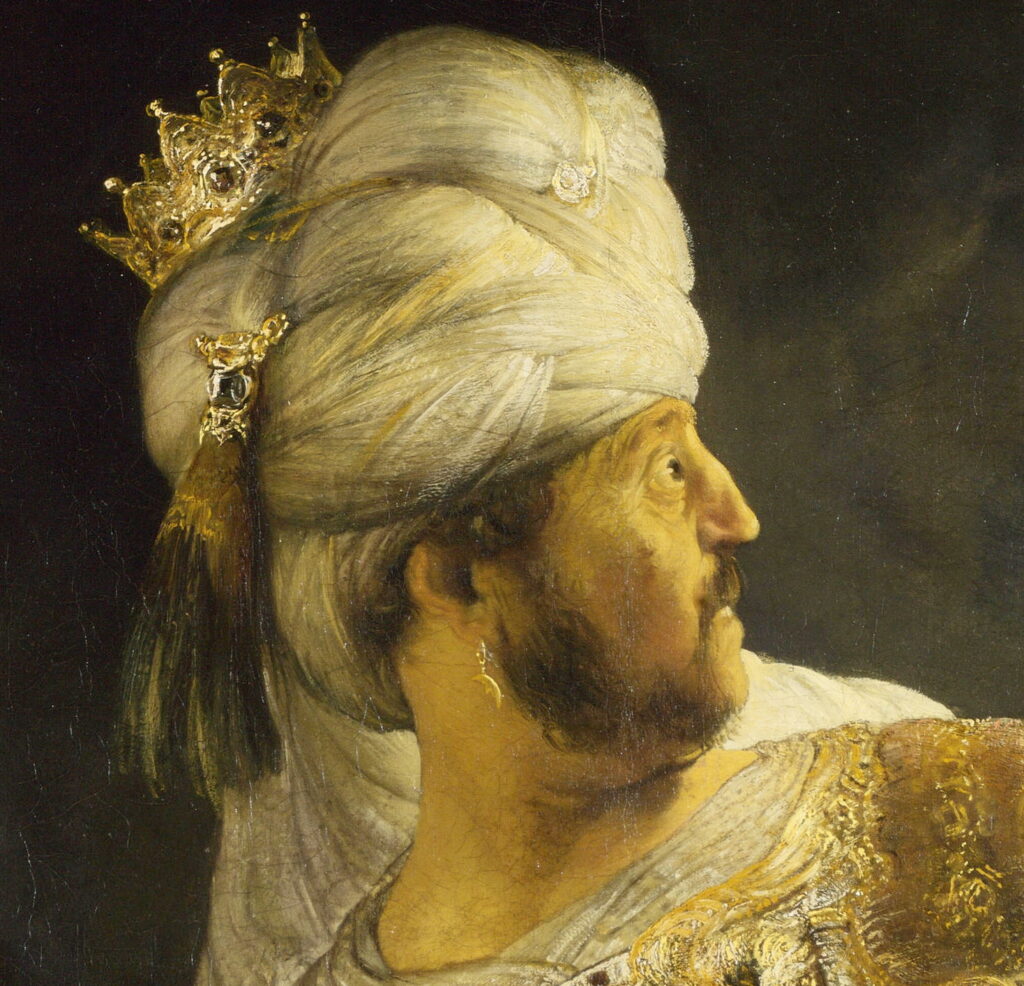Reading visual art: 99 Feasts sacred

One of the best locations for a painting, whether in a house of religion, mansion or palace, is in the eating hall. During the sixteenth century in particular paintings were used to brighten up the refectories of many monasteries. What could be more appropriate for such locations than paintings of feasts, whether sacred or secular? In today’s article, I show some examples of well-known religious feasts or ‘suppers’, and tomorrow I conclude with those drawn from classical myth.
For Christians, the most important supper of them all was the last, in which Jesus dined for the last time with his disciples before his crucifixion.
Giampietrino (1495–1549), copy after Leonardo da Vinci (1452–1519), The Last Supper (c 1520), oil on canvas, 298 x 770 cm, The Royal Academy of Arts, London. Wikimedia Commons.
The most famous painting of The Last Supper, and one of the best-known works in the European canon, is of course Leonardo da Vinci’s. Giampietrino’s copy from about 1520 gives the closest impression today of what the original must have looked like. Even this copy has been horribly mutilated: the upper third was cut off, and its width reduced, but at least what remains gives a better idea of the original’s appearance.
Leonardo’s composition wasn’t entirely revolutionary for the time. Previous paintings of The Last Supper had spread the apostles along the length of a table, with Christ at its centre. However, Judas Iscariot was usually placed alone on the near side, his back to the viewer, and sometimes with his bag of silver visible behind his back.
Leonardo shows the moment of surprise and denial when Christ announces that one of those sat around the table would betray him. In this, he was perhaps the first artist to assemble the apostles into small groups, a feature that has been repeated in innumerable images following this painting. For not only must this be one of the greatest works of European art, it must have spawned more copies and parodies than any other too.
Jacopo Bassano (1510–1592), The Last Supper (c 1546), oil on canvas, 168 × 270 cm, Galleria Borghese, Rome, Italy. Wikimedia Commons.
In about 1546, Jacopo Bassano took the traditional formal view and added informality. The apostles are now loosely engaged in various discussions and activities, lounging against the table, and almost ignoring the standing figure of Christ. An irregular row of bare feet seen under the table emphasises this informality further. Jesus’ left hand touches a symbolic lamb’s head on a platter, and the apostle in front of him, John the Evangelist by tradition, has fallen asleep.
Jacopo Tintoretto (c 1518-1594), The Last Supper (E&I 95) (c 1563-64), oil on canvas, 221 x 413 cm, Chapel of the Sacrament, San Trovaso, Venice, Italy. Image by Sailko, via Wikimedia Commons.
Jacopo Tintoretto’s version from 1563-64 is so radically informal that it still shocked John Ruskin when he saw it three centuries later. Its table is almost square and low-set, with Jesus leaning back and talking quite casually. Twelve apostles sit, lounge, slump and lean around the table, of which one at the right is even eating his meal from his lap. There’s a rough assortment of seating, with a chair resting on its side under the table, as if hurriedly abandoned, which is perhaps a reference to Judas Iscariot.
While others continued to paint the Last Supper, Paolo Veronese turned his brush to other feasts and suppers of the New Testament. One of the first of these, The Supper at Emmaus, possibly dating from as early as 1555, seems to have been an experiment that succeeded.
Paolo Veronese (1528–1588), The Supper at Emmaus (c 1559), oil on canvas, 241 × 415 cm, Musée du Louvre, Paris. Wikimedia Commons.
At its heart is the gospel narrative: after his crucifixion and resurrection, Christ appeared several times to his disciples. In this episode, two disciples had travelled on the road from Jerusalem to Emmaus as pilgrims, and recognised Christ as he “sat at meat with them, he took bread, and blessed it, and brake, and gave it to them.”
The painting contains separate passages to cue this narrative: on the far left is an asynchronous ‘flashback’ referring to the journey to Emmaus. Christ is in the centre of the painting, identified by his halo, and in the midst of breaking bread. With him at the table are the two bearded figures of the disciples, dressed as pilgrims and bearing staves. On Christ’s right is a servant, acting as waiter to the group.
This leaves us to account for the other onlookers: three men, a woman, five boys, four girls, and a baby, together with assorted pet animals. The adults and children are dressed in contemporary costume, rather than the robes of the early first century, and it’s that which makes it clear this is also a family portrait, part of the narrative of the life of an aristocratic Italian family of the day.
A few years later, Veronese was commissioned to paint his much larger Marriage Feast at Cana (1562-3) for the refectory of the Benedictine Monastery of San Giorgio Maggiore in Venice.
Paolo Veronese (1528–1588), The Marriage Feast at Cana (1562-3), oil on canvas, 667 × 994 cm, Musée du Louvre, Paris. Wikimedia Commons.
Its central narrative is another episode of the ministry of Christ as recorded in the gospels. Here, Christ and his disciples were invited to a wedding feast in Cana, Galilee. Towards its end, the wine started to run out, and he was asked what they should do. He directed servants to fill jugs with water, which he then miraculously turned into wine.
The huge canvas shows Christ, distinguished by his halo, at the centre of his disciples, with the Virgin Mary (also with halo) at his right, and sundry disciples arrayed along that side of the tables. The wedding group is at the far left of the party. At the far right of the canvas, wine is shown being poured from a large container, a clear cue to the gospel narrative.
There’s also a great deal of other activity, in every part of the painting. On the balcony behind Christ there are scenes of the butchery of meat, generally claimed to be lamb and symbolic of Christ’s future death as a sacrifice for mankind, as the ‘Lamb of God’, although there are no visual cues to support that interpretation. In the musicians below, and other guests, it’s claimed that there are portraits of artists, including Veronese himself, and Titian. Other important figures who are supposed to be shown include Eleanor of Austria, Francis I of France, Mary I of England, Suleiman the Magnificent, and Emperor Charles V.
A few suppers and sundry masterworks later, in 1578, Veronese painted his spectacular Feast in the House of Simon the Pharisee.
Paolo Veronese (1528–1588), The Feast in the House of Simon the Pharisee (1570), oil on canvas, 454 x 974 cm, Château de Versailles, Versailles. Wikimedia Commons.
Its gospel narrative is another feast, here in the house of Simon, a Pharisee. According to the gospel of Luke, chapter 7, during this Christ’s feet were anointed by a ‘sinful woman’, and he told the parable of the two debtors.
Slightly to the right of centre, Veronese shows Christ, this time without a halo. A woman is indeed anointing his right foot, the empty jar of precious ointment discarded in front of her. Sat opposite Christ, and apparently in discussion with him, is the pharisee of the title. Beyond that central group, there are many other events in progress. At the left of the painting is a group in active discussion, of whom several wear anachronistic or inappropriate dress, suggesting that they’re from a different time and place. There are similar disparities at the right of the painting too, where the figure at the centre looks to be of contemporary Italian origin.
Then in 1573 came his most ambitious yet, now known as The Feast in the House of Levi, only that wasn’t its original title at all.
Paolo Veronese (1528–1588), The Feast in the House of Levi (1573), oil on canvas, 555 × 1280 cm, Galleria dell’Accademia, Venice. Wikimedia Commons.
Veronese painted this thirteen metre-long (forty-two feet) scene for the refectory of the Dominican Friary of the Basilica di Santi Giovanni e Paolo, but it was intended to show the Last Supper. However, he over-reached himself, and the painting was deemed so offensive that he was brought before the Inquisition accused of blasphemy. Thankfully the Inquisition didn’t impose any penalty on Veronese himself, but required that he ‘correct’ the painting within a period of three months. This he did by changing its title, not its content, to The Feast in the House of Levi.
The new central narrative then became that of a feast hosted by Levi, a tax collector, for other tax collectors and their like. Christ’s attendance was criticised by the scribes and pharisees, leading to his answer “They that are whole need not a physician; but they that are sick. I came not to call the righteous, but sinners to repentance.” Christ is shown in the centre of the painting, further emphasised by his halo. In addition to the standard row of disciples, Veronese adds a rich collection of other figures, described by the Inquisition as “buffoons, drunken Germans, dwarfs and other such scurrilities”, more in the manner of a Venetian feast.
Bartholomäus Strobel (1591–1647), Decapitation of Saint John the Baptist at Herod’s Banquet (c 1630-33), oil on canvas, 280 × 952 cm, Museo Nacional del Prado, Madrid. Wikimedia Commons.
Bartholomäus Strobel’s long panoramic view of the Decapitation of Saint John the Baptist at Herod’s Banquet (c 1630-33) concentrates on Herod’s grand banquet, with many ranks of nobles gathered there. At the far right, the executioner stands by John’s headless corpse, a large pool of bright blood on the ground where its head once lay. A young woman (who might be Salome) looks up to heaven, her hands clasped in prayer, while an older woman (presumably Herodias) chats with the executioner.
One feast from the Old Testament has also been painted by several masters, that of King Belshazzar, son of Nebuchadnezzar, and King of Babylon. Although not wholly bad, he didn’t fear and respect God. He threw a great feast for a thousand of his lords, and demanded that the holy vessels be brought from the Temple in Jerusalem for use at his feast, a highly irreverent act. As the thousand lords raised their goblets to celebrate Belshazzar’s greatness, a hand appeared and wrote some Hebrew letters on the wall.
Belshazzar called on his magicians and soothsayers to interpret the letters, but they could not. It was Belshazzar’s wife who suggested that Daniel be summoned. When he arrived, Belshazzar offered to make him third in rank in the kingdom if he could translate the Hebrew letters; although he refused the honour, Daniel translated.
In doing so, he reminded Belshazzar of how God threw his father down until he learned subservience to God. Daniel pointed out that Belshazzar had been drinking from the Temple vessels but had not given honour to God. Accordingly God wrote the words mene, mene, tekel, parsin, translated and explicated as God has numbered the days of your kingdom and brought it to an end, you have been weighed and found wanting, and your kingdom is divided and given to the Medes and Persians. That night, Belshazzar was killed, and his kingdom passed to King Darius the Mede.
Rembrandt Harmenszoon van Rijn (1606-1669), Belshazzar’s Feast (c 1635-1638), oil on canvas, 167.6 x 209.2 cm, The National Gallery, London. Wikimedia Commons.
By far the best-known painting of Belshazzar’s Feast is of course Rembrandt’s, painted around 1635-38. Belshazzar stands, taken aback to the point where his eyes appear to be popping out, as he watches the disembodied hand trace out the foreign letters on the wall behind him. His right hand is steadying him against a salver on the table, having knocked one of the Temple vessels over, his left hand is held up in amazement, as if to push the vision away from him.
The English painter John Martin is best known for his apocalyptic visions expressed onto vast canvases. But following a challenge from his American artist friend Washington Allston (see below) before he left the UK in 1818, Martin painted three historical scenes from Babylon, including Belshazzar’s Feast in 1820-21.
John Martin (1789–1854), Belshazzar’s Feast (1820), oil on canvas, 90.2 x 130.2 cm, Yale Center for British Art, New Haven, CT. Wikimedia Commons.
Martin chooses a different moment in the story, and the other end of the scale as far as its pictorial scope. The thousand lords are shown feasting in vast open-roofed halls. Above them are the famous Hanging Gardens of Babylon, with the Tower of Babel in the distance, and a ziggurat slightly closer. The Top Tables are in the foreground, Daniel standing prominent in a black cloak explaining the meaning of the words. Belshazzar and his royal entourage are recoiling in shock around his throne at the far right.
Martin’s American friend Allston appears to have started work on his own version around 1817, while still in Britain, and didn’t complete it until about 1843. Although he also used a huge canvas, of over 3.5 by nearly 5 metres size, his approach attempts to capture the same human intimacy as Rembrandt.
Washington Allston (1779-1843), Belshazzar’s Feast (1817/1843), oil on canvas, 366.1 x 488 cm, Detroit Institute of Arts, Detroit, MI. The Athenaeum.
He shows Daniel, in the centre and dressed in black, explaining the meaning of the writing on the wall (off the right edge of the painting) to Belshazzar and his queen, at the left. The cluster of men seen at the right are presumably the magicians and soothsayers who failed to interpret the writing before Daniel was summoned.



